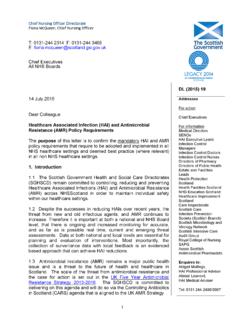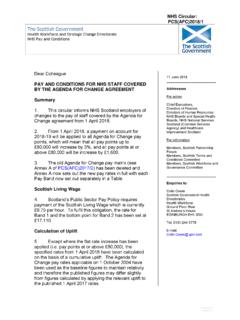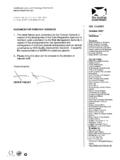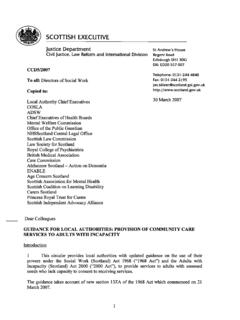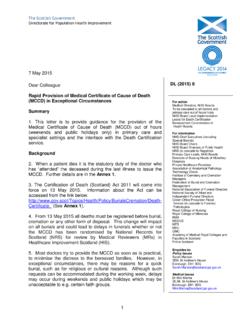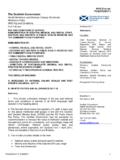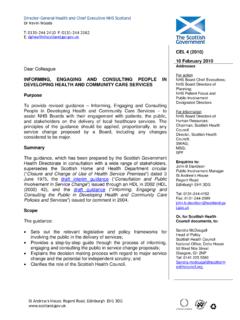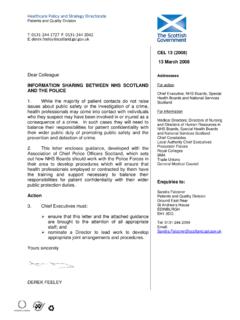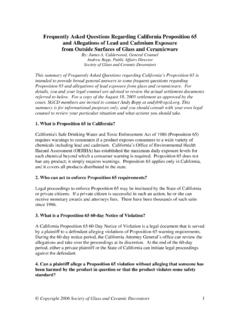Transcription of Directorate of Chief Medical Office and Procurator …
1 St Andrew s House, Regent Road, Edinburgh EH1 3DG Directorate of Chief Medical Office Crown Agent and Chief Executive of Crown Office and Procurator Fiscal Service Dear Colleague MANAGEMENT OF DEATHS IN THE COMMUNITY (In hours and out of hours) Purpose 1. This communication is to provide guidance to colleagues in NHSS cotland and Police Scotland, clarifying the roles and responsibilities of individuals and organisations in the management of deaths in the community. 2. This supersedes the instruction sent by Police Scotland in December 2014, 2014-12 Communications on attendance at sudden death for NHS Boards . The guidance will come into effect from 9am on the 29 February 2016. Background 3. Death of a loved one is stressful at any time. Several anecdotes have provided examples of situations where the distress to all concerned, including the staff, has increased when there is a lack of co-ordination of the process at this sensitive time.
2 This is particularly so when there needs to be an investigation by the Crown Office and Procurator Fiscal Service, assisted by Police Scotland. Sometimes Police are called by relatives/friends/neighbours to attend the death. Police attendance does not mean Police involvement investigations of suspicious circumstances. Principles 4. The primary aim of the Emergency Services is to preserve life. Any preservation of the scene where death occurred, and consequential Police investigation is secondary to this aim. From the Chief Medical Officer Dr Catherine Calderwood Crown Agent, Chief Executive Catherine Dyer and ACC Malcolm Graham, Police Scotland _____ Enquiries to: Crown Office and Procurator Fiscal Service issues David Green Head of the Scottish Fatalities Investigation Unit (SFIU) COPFS Police Scotland issues Steven Cartwright Detective Inspector, Forensic Improvement Project, SCD _____ 21 January 2016 _____ SGHD/CMO(2016)2 _____ Addresses For action NHS Board Medical Directors to cascade to all doctors, including GPs NHS Board Directors of Nursing NHS Board and Special Board Chief Executives to cascade to Medical Fecords Managers Police Scotland For information NHS Board Directors of Public Health NHS Board and Special Board Chairs NHS Board Primary Care Leads to cascade to OOH.
3 Forensic Medical Services and Integration Joint Boards Bereavement Co-ordinators of Health Boards British Medical Association General Medical Council Medical and Dental Defence Union of Scotland Medical Protection Society Medical Defence Union Academy of Medical Royal Colleges and Faculties in Scotland COPFS to cascade to Forensic Pathologists Care Inspectorate Chief Executive Local Authorities National Association of Funeral Directors The National Society Of Allied And Independent Funeral Directors _____ Further Enquiries For clinical issues Dr Mini Mishra Senior Medical Officer St Andrew s House EDINBURGH EH1 3DG St Andrew s House, Regent Road, Edinburgh EH1 3DG 5. Formal verification of the fact of death/pronouncing life extinct (PLE) is not required in all cases of deaths where the Police are involved. 6. Unnecessary interference and delays should be avoided. In order to minimise any additional distress and maximise the efficiency, effectiveness and quality of care, individuals and organisations need to understand their roles and responsibilities and agree which service(s) are most appropriate to attend.
4 7. Appropriate tailored support should be provided to the bereaved where required in the event of suspicious or non-suspicious deaths. Supporting the bereaved is a legitimate business of NHS healthcare services. 8. The attached guidance in the Appendix is not prescriptive and provides a framework within which organisations should jointly agree processes in their local areas together and also within their own organisations, to suit their circumstances. Action 9. We would be grateful if you could bring this guidance to the attention of relevant colleagues in your organisations. 10. Finally, we are very grateful for the on-going support and commitment of all staff involved in continuing to jointly implement this challenging process in a sensitive area. Yours sincerely Catherine Calderwood Catherine Dyer ACC Malcolm Graham 1 APPENDIX Guidance for deaths in and out of hospital setting, in hours and out of hours (latter covered by primary care Out of Hours services) Background The management of deaths in the community is a challenge for all the professionals concerned, as the responses required may be complex, and come at a very sensitive and difficult time for the bereaved.
5 Empathetic handling, tailored to each situation, can reduce unnecessary stress for all concerned, including the professionals involved. For the emergency service preservation of life is paramount. Subsequent considerations of verifying the fact of death (VoD)/pronouncing life extinct (PLE) and preserving evidence must be secondary to this primary role. PLE will include references to both PLE and VoD in this document. In circumstances where death is clearly evident, such as decapitation or advanced decomposition, there is no requirement for a formal PLE by a healthcare professional. In these circumstances the Police will record Time Found and remove the deceased to a relevant mortuary. To assist in determining some of the numbers involved, Police Scotland have recently undertaken analysis of death related incidents reported to them, in the West and East regions of Scotland, covering over half of the population in Scotland. In summary: 134 deaths were reported to Police Scotland during a 7 day period in June 2015, half of which were reported by Scottish Ambulance Service (SAS).
6 SAS were not requested to attend in 13 incidents, in circumstances where their attendance should have been considered. A forensic physician (FP) was in attendance at 5 of those 134 occasions, and was requested to PLE. On 4 of those 134 occasions, primary care Out of Hours Services (OOH) were requested to attend. Of these, there were 2 cases where SAS was also in attendance, and PLE done by them. 25 of these 134 deaths were suspicious and/or within the responsibility of the Police, yet on 107 occasions Police removed the deceased to a mortuary and reported the circumstances of the death to Crown Office and Procurator Fiscal Service (COPFS). This brief analysis undertaken by Police Scotland recently, reveals that out of 134 cases SAS were not summoned in around 10% of those cases but that in most cases their attendance or clinical advice would have been valuable, in the interests of preservation of life. It also indicates that the majority of deaths that the Police are currently attending and managing are not within their scope of work or responsibility.
7 2 This can lead to a disproportionate response and inefficiencies in the process, which can combine to add to the bereaved relatives distress. For example, only 25 out of the 134 of the above cases were suspicious and/or within the responsibility of the Police, yet on 107 occasions the Police removed the deceased to a mortuary and reported the death to the COPFS. It would appear reasonable to consider which service(s) are the most appropriate to attend a death in the community, recognising the duty of care to the deceased and the needs of the bereaved when a possible death is reported, including the preservation of life wherever possible. In the very few cases, where the death is not suspicious or unexplained ( the likelihood of the death being reported to the Procurator Fiscal (PF) is extremely low), primary care services (in hours and out of hours) are responsible for PLE in order to authorise the deceased to be removed respectfully by the funeral directors.
8 The example in the paragraph above appears to illustrate confusion and lack of co-ordination and consistency of approach in the manner in which services jointly manage deaths in the community. This guidance aims to provide clarity of the roles and responsibilities of the various professionals involved in the management of deaths in the community. The guidance is not prescriptive, but provides a framework within which organisations locally can jointly develop and agree their process to enable the smooth management of deaths in their communities. Principles Preservation of Life The primary responsibility of the Emergency Services (SAS, Police Scotland and Scottish Fire and Rescue Service) is to preserve life and keep people safe. Although, Police officers will attend to provide any assistance required, they cannot make clinical decisions about a casualty . Where SAS are not in attendance and the Police are first on the scene, the Police will inform SAS of the circumstances to enable an appropriate emergency clinical response.
9 This applies to all emergency services but the main role lies with SAS. SAS would be required to attend if there is any doubt about life being extinct but would not be required in confirmed deaths dismembered or decomposed bodies, or in circumstances where resuscitation is not required Do Not Attempt Cardio Pulmonary Resuscitation (DNACPR). PLE In the vast majority of deaths in the community a PLE will be undertaken by a trained and competent paramedic on the verification of death from SAS. In some cases where Police involvement is not required and attendance of SAS and the Police is inappropriate and not required, there is a DNACPR form, it is the responsibility of primary care services (in hours and out of hours) to PLE, so that the deceased can be removed respectfully by the funeral directors appointed by the family of the deceased. SAS will not attend merely to formally PLE if death has 3 already been confirmed. If such a death is reportable to the PF, the deceased s GP will notify the PF on the same day (if the PLE is undertaken in hours), or the next working day (if the PLE is undertaken in OOHs).
10 In the very rare circumstances where the death requires Police involvement, and SAS is not present or not required to attend, it will the responsibility of the FP or a trained and competent forensic nurse on the verification of death to attend to PLE. The role of the FP or the forensic nurse in such circumstances does not include the requirement to provide an opinion on the cause of death. Forensic Pathologists should only attend the scene/death on the instruction of the PF. Formal PLE is not required in all suspicious deaths ( where Police involvement is required), as the Police officers are able to note the Time Found in some circumstances and authorise the removal of the deceased to a mortuary under their own contractual arrangements. This will enable the forensic pathologist to undertake their work as soon as possible. PLE is required for non-suspicious ( where Police involvement is not required), deaths to authorise the funeral directors chosen by the family of the deceased to respectfully remove and store the body appropriately, until further instructions.
